Forklifts vs. Overhead Cranes: Which is the Best for Your Business?
When it comes to material handling there are two standard options for lifting and moving loads—overhead cranes and forklifts. While these two types of machines perform similar functions, there are also distinct differences between the two—especially when it comes to safety and efficiency.
Have you noticed that accidents or near misses in your facility often involve the use of a forklift? This could include damage to nearby structures, to the forklift itself, or even a failed lift.
Or maybe you are looking to upgrade your facility, expand your facility, or move into a new facility and you’re wondering if adding an overhead crane could improve your production processes?
When it comes to material handling there are two standard options for lifting and moving loads—overhead cranes and forklifts. While these two types of machines can move material through your facility, there are distinct differences between the two—especially when it comes to safety and efficiency.
Our goal with this article is to help you establish a base-level understanding of forklifts and overhead cranes and how they differ from one another. In this article, you’ll learn more about:
- What a forklift is and what it is used for
- Advantages and disadvantages of forklifts
- What an overhead crane is and what it is used for
- Advantages and disadvantages of overhead cranes
- Reasons to upgrade from a forklift to an overhead crane
What is a Forklift?
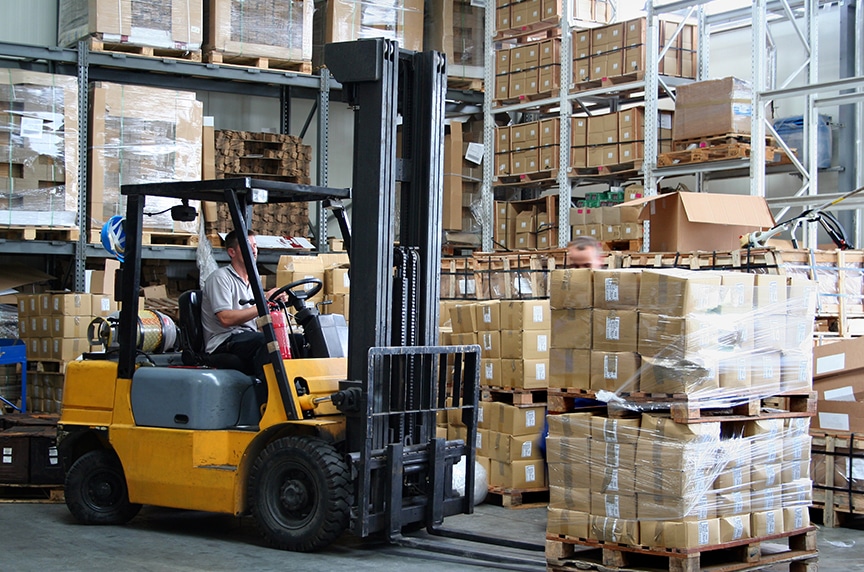
A forklift is a piece of material handling equipment driven and controlled by an operator from the ground level. It consists of a truck carriage—in which the operator sits—accompanied by two extending forks meant for sliding underneath and lifting pallets.
A standard straight mast forklift utilizes the extended forks to lift and lower palletized loads throughout a facility. In extension forklifts, the forks also extend to lift the load inwards and outwards.
Forklifts are most commonly found in warehouse and manufacturing environments where they can be used for lifting and stacking pallets on shelving. They are also commonly used for:
- Loading and unloading delivery trucks
- Transporting product from inside to outside and vice versa
- Manufacturing and fabrication
- Lifting heavy coil and other materials in steel mills
- And more!
Advantages of Forklifts
Size / Mobility
Forklifts, in comparison to most types of overhead cranes, are much smaller. In addition, since forklifts are mobile rather than stationary, they are much more maneuverable than overhead cranes. Forklifts can be driven between narrow aisles, adjust to changes in elevation, and carry materials between buildings.
Lower Initial Price
The initial price of purchasing a forklift is significantly less in comparison to most overhead crane options. Because forklifts are more susceptible to damage and often require more maintenance than an overhead crane, it is very possible that the long-term cost of a forklift outweighs the initial cost of an overhead crane.
Disadvantages of Forklifts
Shorter Life Expectancy
The life expectancy of a forklift is only about 10-15 years in comparison to overhead cranes which can remain in service upwards of 65 years. Because forklifts have a significantly shorter life expectancy, it is more common for a business to lease a forklift as opposed to buying them outright.
Lift Capacity Diminishes with Height
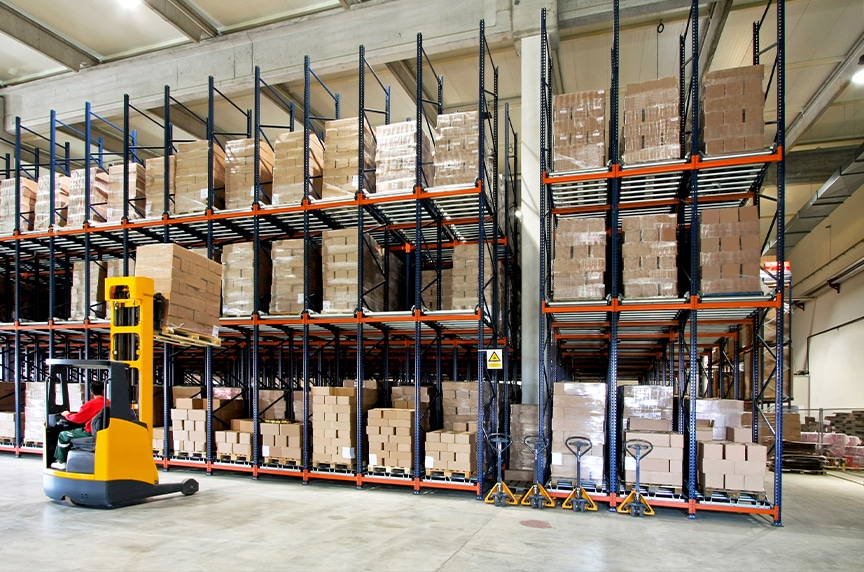
The forks on a typical forklift extends upwards anywhere from 15-18 feet. As the forks extend upwards—or outwards in cases where you are using an extension forklift—the capacity decreases. The higher the lift takes the load, the less weight the forks can safely lift.
In addition, the higher you need to lift items in your facility, the bigger—and more expensive—the forklift will need to be in order to support the load weight.
Susceptible to Damage
Because forklifts are mobile machines—compared to overhead cranes that are stationary on a rail—it is much more common for them to get damaged, and cause damage, from driving around the facility and bumping into racking, walls, dock doors, or other items.
It’s not uncommon for forklift operators to mistakenly damage both the forklift and surrounding racking systems, especially in warehouse environments where there is high employee turnover and fast-paced operations.
Frequent damage to the forklifts—and racking systems—can lead to a significant monthly cost in repairs.
More Labor Required
Forklift operation usually requires two people. One employee has to drive / operate the machine while the other helps rig the load and spot for the operator. In some cases, the operation of a forklift requires three employees.
Not only does this require more time and labor, but when an extra person is needed to operate the forklift, you have to pull an employee from somewhere else in the shop, resulting in downtime elsewhere.
What is an Overhead Crane?
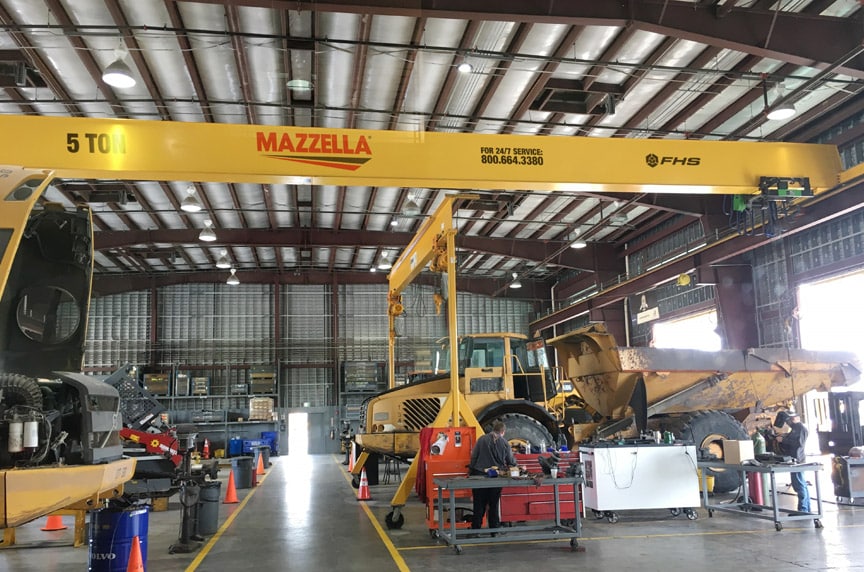
On an overhead crane, a horizontal beam called the bridge travels up and down a runway on a track or rail. A trolley and hoist move side to side along the bridge to lift and lower loads throughout a rectangular bay. These types of cranes are used to increase safety and efficiency within a warehouse or other facility and have varying load limits ranging anywhere from .25 to 400 tons.
The basic way to identify an overhead crane is that it’s exactly what it sounds like, overhead—the beam moves horizontally up and down a runway above a facility or construction site along a fixed path.
Overhead cranes are usually permanent structures in facilities or construction sites where they are installed for repetitive workflow use.
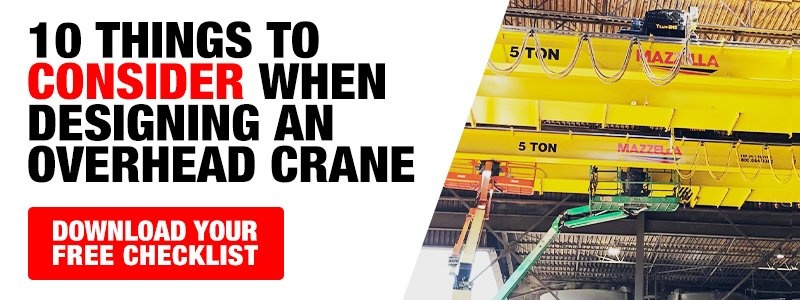
Advantages of Overhead Cranes
Longer Life Expectancy
It’s not uncommon for an overhead crane to last upwards of 65 years as opposed to the expected life of a forklift of about 10-15 years. This is because overhead cranes are custom built for the application at hand and less susceptible to damage.
Minimizes Accidents
Due to their mobility on the ground, it’s not uncommon for a forklift operator to mistakenly collide with other objects or storage racking. Overhead cranes, on the other hand, remain a stationary part of the building structure and simply maneuver over any structures / racking below—making it much less likely to be involved in any accidents.
A crane bay design that is free of obstacles, obstructions, and employees will help to maximize safety and prevent accidents.
Space Savings
A standard forklift requires 12-foot aisles to navigate through rows of storage to place and remove loads from racking, whereas overhead cranes can maneuver directly over the contents of a facility. Whether or not these aisles will be needed is something to consider when designing a warehouse pallet racking system.
Maintains Lift Capacity / Higher Overall Capacity
Overhead cranes have a much higher potential lift capacity. Overhead crane capacities can run upwards of 400 tons whereas some of the largest forklifts will max out around 70 tons.
Unlike a forklift, an overhead crane maintains the same capacity regardless of how high or low the load is lifted.
Designed Specifically for the Application
In most cases, an overhead crane is built specifically for the facility and task at hand. Meaning, that many of the components and functions of the crane are custom designed to withstand rigors of repetitive lifts and the specific products and product flow in your facility. These specialized components support a longer service life, less breakdowns, and help keep production running.
A big part of custom designing an overhead crane is choosing which CMAA service class is best for your business. Crane service classifications allow you to select and build an overhead crane that is the most economical and safest design for your lifting application. Selecting the right duty cycle or service classification of an overhead crane helps ensure that the components of the overhead crane are durable enough to withstand the load and usage requirements.
Disadvantages of Overhead Cranes
Higher Initial Price
The high initial price can often be the biggest hesitation in a customer’s decision to purchase an overhead crane. Compared to a forklift, there will be a larger upfront cost when buying an overhead crane.
However, using an overhead crane in place of forklifts in your facility typically leads to savings in the long run related to maintenance, safety, and repairs.
Large and Semi-Permanent
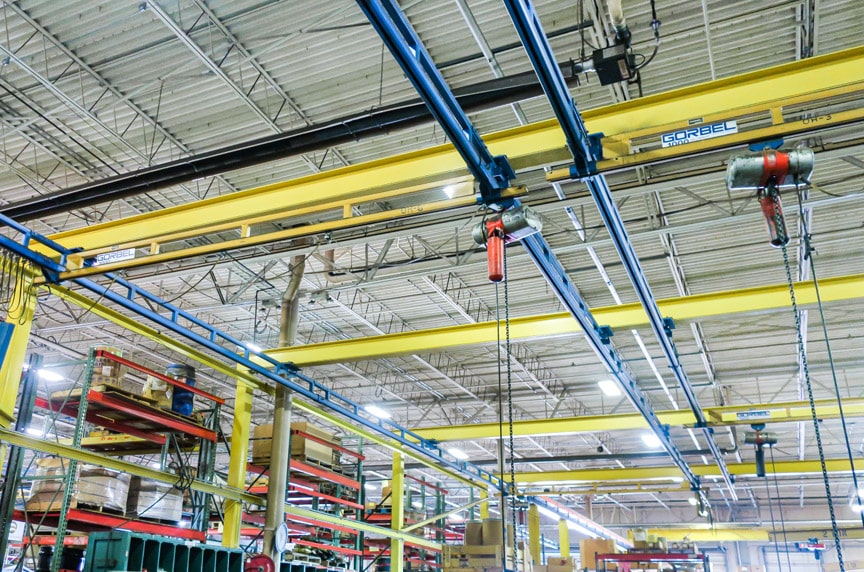
Overhead cranes—unless they are a smaller jib crane or workstation crane—are typically going to be much larger than a forklift. If an overhead crane is initially built into the facility, they are typically supported by the infrastructure of the building. However, if the crane is freestanding, it will require support columns to be placed throughout the facility which can take up a significant amount of space.
Since cranes are typically built into the structure of a facility—whether it be part of the initial design or a retrofit—it is a near permanent structure of the building. Because of the large size of overhead cranes and the way they are built into a building’s structure, it is very difficult and sometimes impossible to move a crane from one facility to another. In some cases, the overhead crane is even part of a building’s lease agreement.
Height of Storage Racking
The height of storage racking or other structures present within the crane bay will need to be shorter than in other parts of the facility, as the crane must be able to maneuver over anything present within the bay. This leads to slightly less storage capacity in your facility.
In rarer cases, an overhead crane can be incorporated into the racking system. It is more common, however, for the crane to be an entirely separate entity.
Reasons to Upgrade from a Forklift to an Overhead Crane
We asked our Crane Technical Specialists what some of the most common reasons are for a customer to upgrade from a forklift to an overhead crane.
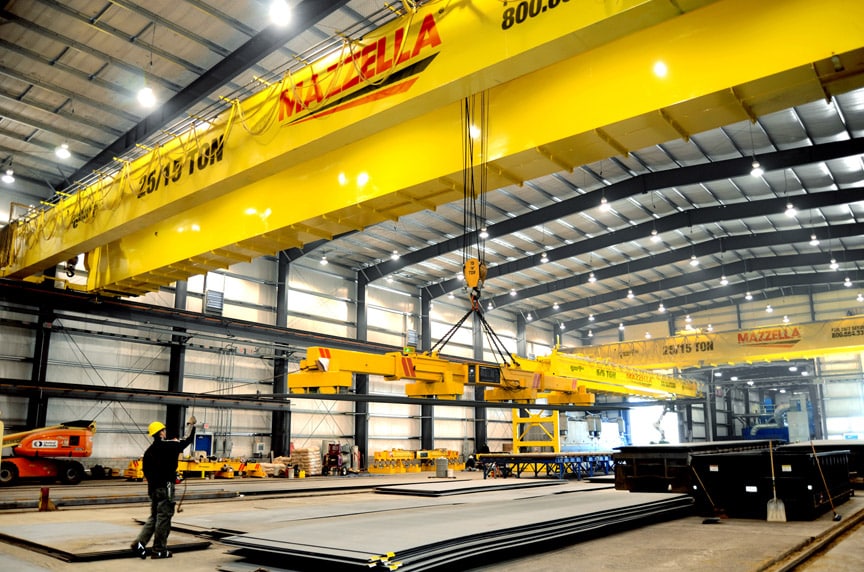
A Near Miss or Injury
The most common reason for switching from forklifts to an overhead crane is an accident, near miss, or injury. As mentioned above, overhead cranes tend to be safer than forklifts and yield fewer accidents.
It’s critical to maintain a safe environment for your employees. It’s also important to note that one claim to a workman’s compensation can completely outweigh the cost of any crane purchase—making it a worthwhile investment.
A Process or Production Has Changed
Something has changed in your manufacturing or production processes. That change can be related to a number of different things, including:
- Lifting a new type of material
- Lifting a heavier type of material
- Making more frequent lifts
Any of these changes can create additional wear and tear on forklifts. Making more frequent or heavier lifts can put a strain on your equipment if the demands of the new process exceed the capabilities that they were originally intended for.
Over time, this can lead to premature wear or even failure of your forklift equipment. Costs related to service calls to repair or replace individual components can add up and eventually exceed the cost of a new piece of equipment, or an initial investment into a crane system.
Customization
Overhead cranes can be completely customized to fit any facility and, unlike a forklift, are designed for the specific application at hand. This leads to more efficient workflows and longer-lasting material handling equipment.
Long-Term Savings
Overhead cranes have a longer life expectancy than forklifts and, in some cases, a single overhead crane could replace multiple forklifts.
Forklifts are also associated with frequent repairs, maintenance, and damage to other objects in the facility. In comparison to overhead cranes, forklifts have extra costs associated with:
- Construction walkways
- Installing bumpers to protect racking systems from forklift damage
- Safety-related incidents
So, while an overhead crane may be a larger investment upfront, if utilized correctly, it can save a business money in the long run.
Facility Set-Up
Depending on the set-up of your facility, it may make more sense to install an overhead crane instead of using a forklift. For example, in a facility where loads of over 200 tons need to be regularly lifted, an overhead crane will be necessary.
However, in cases where the material handling equipment is being retrofitted to the facility, it may be easier and quicker to purchase a forklift and begin using it right away. It all depends on the immediate needs of your facility.
Of course, there are also many situations where both overhead cranes and forklifts are successfully used together. In order for any sales staff to determine a recommendation for your facility, it’s important that they thoroughly understand your facility’s workflow and processes.
Wrapping It Up
A short article cannot completely inform a decision on whether to invest in a forklifts or an overhead crane. However, we hope that this article helped you to form a base-level understanding of what forklifts and overhead cranes are and the differences between the two.
Forklifts have a lower initial price and their size and mobility makes it much easier for them to quickly maneuver throughout a facility and between facilities. They also have a short life expectancy, require more labor, are susceptible to damage, and diminish in capacity as the lift height increases.
Overhead cranes have a much longer life expectancy, are effective in minimizing accidents, save aisle space, and have a much higher potential capacity. On the flip side, they have a much higher initial price, are very large and semi-permanent, and must be able to maneuver over anything present in the crane bay.
Some of the most common reasons our crane specialists recommend a switch from forklifts to an overhead crane are:
- A near miss or injury
- A change in a process or production
- Customization
- Long-term savings
- Facility set-up
If you are interested in determining what the best fit for your facility is or want to schedule a consultation, contact us to speak with a specialist.
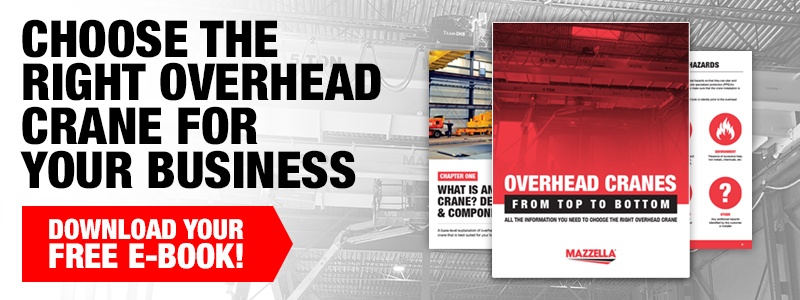
Copyright 2020. Mazzella Companies.
